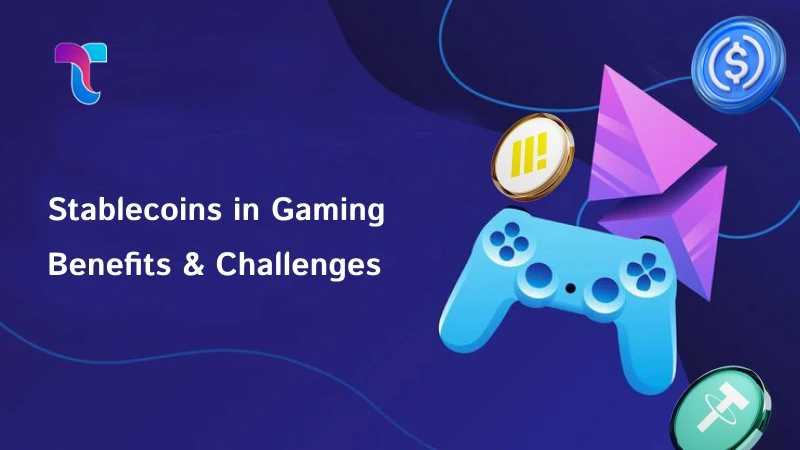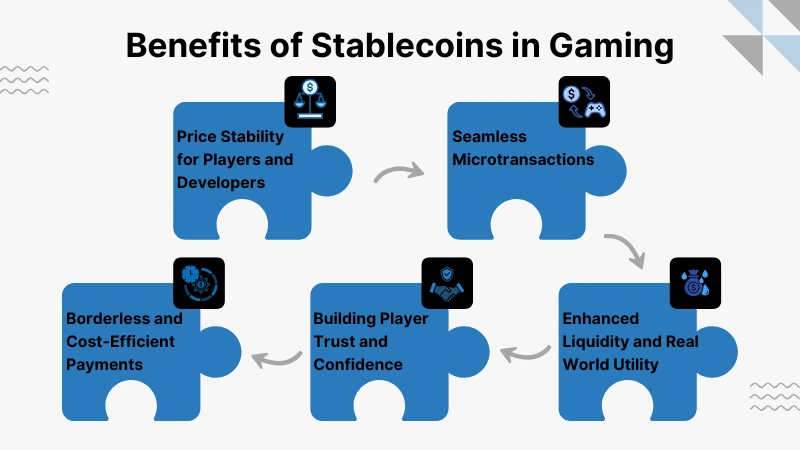Imagine playing a P2E game where you can earn a cryptocurrency that is equally as reliable as fiat currency! Welcome to the world of stablecoins, where the cryptocurrency that you earn is pegged to a stable traditional currency, like US dollars.
The blockchain gaming market has made significant progress in recent years. A recent report from CoinLaw reveals that approximately 54% of all blockchain gamers in the US region possess some form of in-game cryptocurrency. Moreover, play-to-earn (P2E) titles remain at the forefront, achieving over $390 million in NFT trading volume by 2025.
All these statistics show growing interest in the Web3 gaming space. In this blog, we are going to learn about stablecoins, their benefits in gaming, and the various challenges associated with the effective implementation and integration of stablecoins in the gaming industry.
What Are Stablecoins?
Stablecoins are like any other cryptocurrencies, but with a twist! The only difference is that they are much less volatile, as they are backed by a stable currency like gold or euros. They provide users with a stable blend of crypto efficiency and fiat stability.
According to the BIS report, nearly 99% of fiat-backed stablecoins were pegged to United States dollars. Some well-known examples of stablecoins pegged to the US dollar are Tether’s USDT, Circle’s USDC, and Binance’s BUSD. When it comes to euro-pegged stablecoins, it is still catching up with US dollar dominance. To challenge the U.S. monopoly, several prominent players are utilizing Euro pegging, including Circle’s EURC, Tether’s EURT, Monerium’s EUR e-money, and Stasis Euro (EURS).
Benefits of Stablecoins in Gaming
Stablecoins are reshaping how digital economies operate in the gaming ecosystems by offering price stability and reliability. Let’s try to break down the key benefits that they bring to the table:
Price Stability for Players and Developers
Traditional cryptocurrencies like Ethereum and Bitcoin are infamously known for their value fluctuations. Any asset purchased today could depreciate to almost half its value on the next day, depending on market swings. The volatility creates uncertainty both for players and developers, who need predictable pricing for in-game assets, subscriptions, and rewards.
Stablecoins for gamers mean that they can purchase items without worrying about any sudden price dips. For game makers, this means that they can have a stable revenue stream to rely on. This stability is crucial for in-game economies to be more trustworthy and practical, especially in play-to-earn games where players depend on rewards in the form of crypto NFTs.
Seamless Microtransactions
Whether buying a skin, battle passes, or power-ups, they all come under microtransactions, forming the backbone of modern-day gaming. These small-value purchases generate billions in revenue for these gaming giants globally. Cryptocurrencies are significant for instant payments, but volatility often discourages players from using them.
Stablecoins provide a perfect solution for this problem by combining the speed and borderless nature of crypto with predictable pricing. Players can buy and sell items in small amounts without constantly recalculating value. This makes stablecoins an ideal medium to be used for microtransactions, supporting a smoother gameplay experience with easier adoption.
Borderless and Cost-Efficient Payments
Games are inherently built with the global audience in mind. The problem is not connecting global platforms together, but with the payment platforms. Cross-border transactions often cause hurdles due to their complicated conversion rates, high fees, and delays.
Stablecoins eliminate these barriers by enabling instant peer-to-peer transfer at minimal costs. For instance, a gamer in India can buy in-game items from a developer in the U.S. without having to deal with problems with international banking. These accessibility levels for the playing field allow gamers from emerging markets to fully participate in global gaming economies.
Building Player Trust and Confidence
Trust is an essential factor in gaming economies, and many players get skeptical about blockchain-based games due to the fear of losing money from crashes or scams. To increase the adoption of blockchain gaming, it is crucial for game makers to reassure players.
Stablecoins provide a safety net by offering a predictable value system, making users more confident about their participation in games. With rewards being distributed in the form of stablecoins, players know that their earnings won’t be lost overnight. This not only builds credibility for game developers but also helps them tap into a larger audience.
Enhanced Liquidity and Real-World Utility
One of the significant limitations of the in-game currencies is that they are restricted by the game itself. Players couldn’t easily transfer them outside the platform after earning them. This was a massive problem for gamers, as they couldn’t monetize their assets with ease.
For games that implement stablecoins, gamers can not only use them to purchase in-game assets but also for real-world expenses. For example, a gamer can earn rewards in USDC and then use that to pay their online subscriptions, send money to friends, or even turn it into hard cash.
Challenges of Using Stablecoins in Gaming
While stablecoins offer many advantages in gaming, like price stability, trust, and global accessibility, they also have their own set of challenges. Let’s explore some challenges associated with gaming using stablecoin:
Regulatory Uncertainty
One of the most significant problems faced by stablecoins is the lack of clear rules and regulations. Governments around the globe are still in a frenzy about the classification and monitoring of stablecoins. They are in confusion about which category to place them under. Are they currencies, securities, or something else entirely?
For gaming corporations, this creates a risky time to be living in. A programmer might integrate stablecoins into their in-game economy, only to later find out that the regulators in some particular country have banned their game on the basis of a rule made legislative last week.
Risks of Centralization
Although cryptocurrencies are renowned for their decentralization, their characteristics may lead to stablecoins being controlled by centralized organizations. Tokens like USDT (Tether) and USDC (Circle) are supported by reserves that are handled by private companies. This creates a dependency on centralized entities for issuance, redemption, and collateral management.
When we apply this context to gaming, this centralization introduces risks: if the issuer of the stablecoin is facing legal challenges, it can directly affect in-game economies. If a stablecoin were to freeze suddenly, it could really shake things up in gaming. Players and developers might find themselves in a tough spot, not knowing what to do next.
Scalability and Transaction Costs
Stablecoins can be really good at reducing volatility, but they don’t entirely solve the issue of scalability and transaction efficiency on the blockchain network. A lot of stablecoins are built on Ethereum, but the problem is that the network can get really congested. When that happens, gas fees can shoot up, especially during busy times.
Imagine, from the point of view of a gamer, trying to make a small $1 microtransaction, but having to pay $3 in transaction fees. He/she would be devastated to see this. This defeats the whole purpose of enabling affordable and seamless in-game purchases.
Security and Smart Contract Vulnerabilities
Any system built on blockchain carries some technical risks, and stablecoins are no exception. Gaming platforms that use stablecoins depend heavily on smart contracts to handle stuff like transactions, rewards, and asset management.
However, if poorly written or audited, smart contracts can become targets for hijacks. In the past, gaming platforms have lost a ton of money because of these weaknesses in their smart contracts. We might see similar issues with blockchain games development, too. Just a single breach could disrupt the entire cash flow, disrupt the game economies, and cause players to lose trust.
Dependence on External Ecosystems
Stablecoins in gaming don’t exist in isolation, but they depend on a bunch of external blockchain networks, exchanges, and custodians for liquidity and conversion. This dependency can create vulnerabilities that are outside the control of game developers.
For instance, if a stablecoin faces a depegging with fiat currency or a liquidity crisis on exchanges, it can instantly devalue rewards and in-game assets that were tied to it. Such dependencies create systemic risks that could undermine entire gaming ecosystems.
Conclusion
The intersection of blockchain gaming and stablecoins is revolutionizing the landscape of the gaming industry. They are introducing new opportunities for gamers to engage and make a stable income while playing games. The mix of decentralized governance, stablecoin payments, and cool new financial products is definitely going to shape the future of the gaming industry.
The future of gaming and finance looks super exciting, with everyone getting a chance to be involved! It’s like we’re all part of the action. Now, being an early mover in this untapped market will be a massive advantage for you as a developer.
Partnering with a reputable development firm can make the difference between building an iconic game and one that collects dust. At Technoloader, we help firms like you create games using modern technologies that are ready for a scalable future.
Reach out to us today and turn your game idea into reality.
 +91 7014607737
+91 7014607737
 info@technoloader.com
info@technoloader.com





